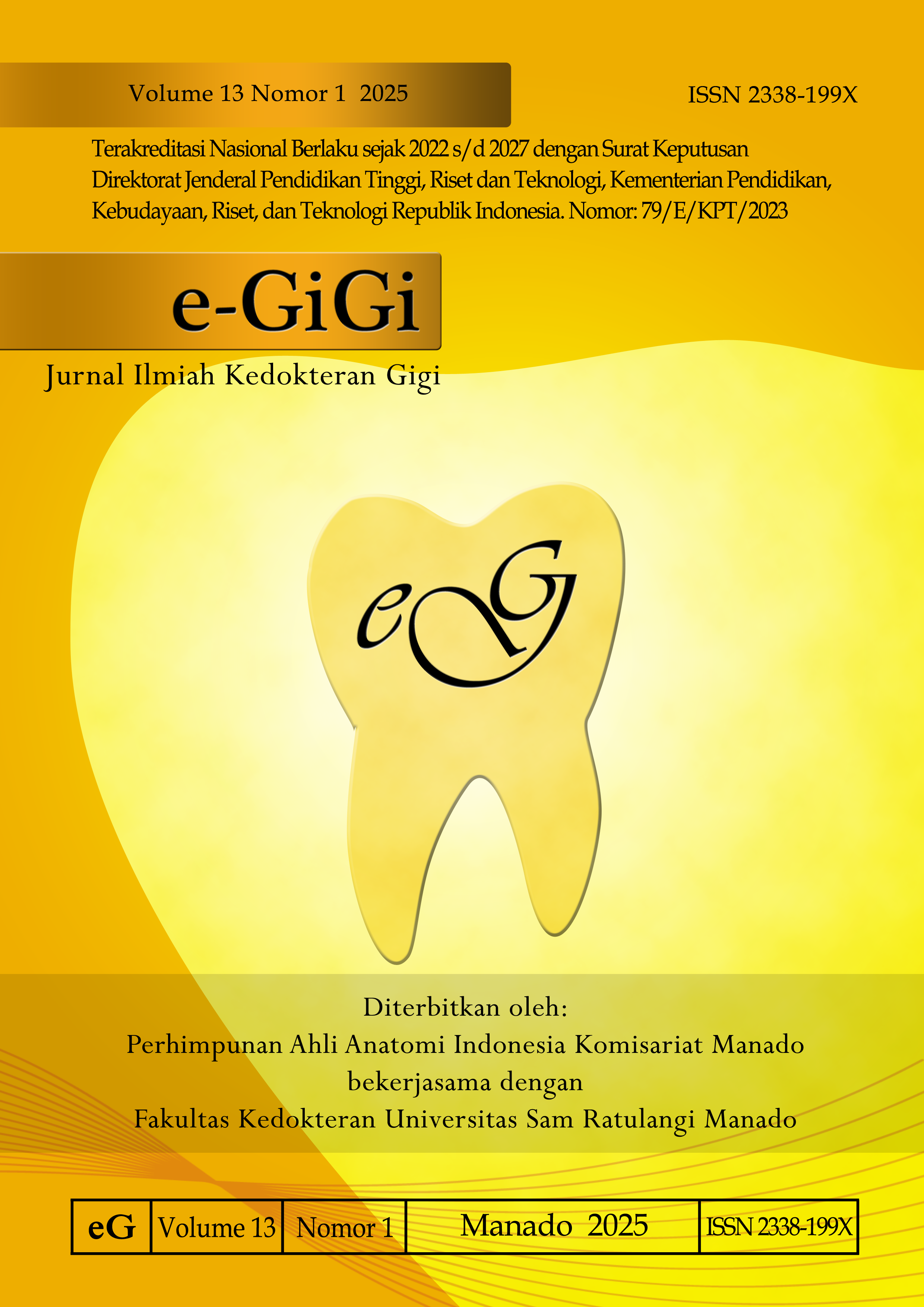Gambaran Pola Sidik Bibir Masyarakat Desa Tateli Tiga
DOI:
https://doi.org/10.35790/eg.v13i1.55685Abstract
Abstract: Lip print pattern offers potential as a fast and effective secondary identification method that can be used in emergency situations. DesaTateli Tiga is a disaster-prone village because it is located in a coastal area of Mandolang District, Minahasa, North Sulawesi. This study aimed to obtain the profile of lip print pattern in people at Desa Tateli Tiga. This was a observational and descriptive studi with a cross sectional design. Samples were people living at Desa Tateli Tiga aged 21-40 years, obtained by using the purposive stratified sampling method as many as 267 people. The results showed that there were 87 males and 180 females as samples. In early adult group, the most frequent type of lip pattern was type 1 (43.65%) and type IV (20.63%). The most common lip profile in males was type IV (43.24%), and in females was type I (56.18%). In late adult group, the most frequent type of lip pattern was type I and type III, each of 27.03%. The most common type of lip pattern in males was type III (44.83%), and in females was type I (37.78%). In conclusion, the lip print pattern of Tateli Tiga people in Minahasa is dominated by perfectly vertical type I and reticular type IV. Type IV is predominant in males meanwhile type I in females.
Keywords: lip print pattern; Suzuki and Tsuchihashi method; identification; sex; age
Abstrak: Penggunaan pola sidik bibir sebagai metode identifikasi sekunder yang cepat dan efektif dapat membantu mempercepat proses identifikasi korban dalam situasi darurat. Desa Tateli Tiga, merupakan salah satu desa yang rawan bencana karena terletak di wilayah pesisir pantai Kecamatan Mandolang, Kabupaten Minahasa, Sulawesi Utara. Penelitian ini bertujuan untuk mengetahui gambaran tipe pola sidik bibir masyarakat Desa Tateli Tiga. Jenis penelitian ialah observasional deskriptif dengan desain potong lintang. Sampel penelitian yaitu masyarakat Desa Tateli Tiga yang berusia usia 21–40 tahun. Teknik pengambilan sampel menggunakan purposive stratified sampling sebanyak 267 orang, ditentukan dengan rumus Slovin. Hasil penelitian mendapatkan sampel laki-laki sebanyak 87 dan perempuan sebanyak 180. Pada populasi dewasa awal, tipe yang paling sering ditemukan ialah tipe I (43,65%) dan tipe IV (20,63%). Tipe pola sidik bibir yang sering ditemukan pada jenis kelamin laki-laki ialah tipe IV (43,24%), dan pada perempuan tipe I (56,18%). Pada populasi dewasa akhir, tipe yang paling sering ditemukan ialah tipe I (27,03%) dan tipe III sama banyak. Tipe pola sidik bibir yang sering ditemukan pada jenis kelamin laki-laki ialah tipe III (44,83%), dan pada perempuan tipe I (37,78%). Simpulan penelitian ini ialah pola sidik bibir masyarakat Desa Tateli Tiga di Kabupaten Minahasa didominasi oleh tipe I vertikal sempurna dan tipe IV retikuler. Tipe IV terbanyak didapatkan pada laki-laki sedangkan tipe I pada perempuan.
Kata kunci: pola sidik bibir; metode Suzuki dan Tsuchihashi; identifikasi korban
References
Datta P, Sood S, Sabarwal JR. Cheiloscopy as a tool for human identification. Indian J Forensic Odonto 2012;5(1):17–3.
Mardiah A, Firdaus, Ismardianita E. Membandingkan pola sidik bibir sebagai sarana identifikasi jenis kelamin pada Suku Minang di Fakultas Kedokteran Gigi Universitas Baiturrahmah Padang tahun 2017. B-Dent. 2017; 4(2):77–82. Doi: https://doi.org/10.33854/JBDjbd.127
Masum M, Akbar A. The pacific ring of fire is working as a home country of geothermal resources in the world. In: IOP Conference Series: Earth and Environmental Science. Institute of Physics Publishing; 2019;249(1):012020. Doi: 10.1088/1755-1315/249/1/012020
Sharma P, Saxena S, Rathod V. Cheiloscopy: the study of lip prints in sex identification. J Forensic Dent Sci 2009;1(1):24–7. Doi: 10.4103/0974-2948.50884
Rai B, Kaur J. Evidence-based Forensic Dentistry. Copenhagen: Springer Science & Business Media; 2012. p. 109–14.
Zopiyactle D. Frequency of lip print patterns among females and males at San Jose State University. Themis: Research Journal of Justice Studies and Forensic Science. 2020;8(1):41-54. Doi: 10.31979/THEMIS.2020.0803
Hendrayana. Ilmu Pengetahuan Sosial Sejarah. Jakarta: Pusat perbukuan Departemen Pendidikan Nasional; 2009. p. 132–4.
Adia AA. Perbedaan pola sidik bibir terhadap jenis kelamin dengan metode Suzuki dan Tsuchihashi pada Populasi Jawa [Doctoral dissertation]. Malang: Universitas Brawijaya; 2019.
Sharma P, Gupta N, Saxena S. Experimental studies of forensic odontology to aid in the identification process. J Forensic Dent Sci. 2010;2(2):69-76. Doi: 10.4103/0975-1475.81285
Randhawa K, Narang RS, Arora PC. Study of the effect of age changes on lip print pattern and its reliability in sex determination. The Journal of Forensic Odonto-stomatology. 2011;29(2):45-51. Available from: https://pubmed.ncbi.nlm.nih.gov/22717913/
Qomariah SN, Novita M, Wulandari E. Hubungan antara pola sidik bibir dengan jenis kelamin pada mahasiswa Fakultas Kedokteran Gigi Universitas Jember. e-Jurnal Pustaka Kesehatan 2016;4(2):385–93. Availabe from: https://jurnal.unej.ac.id/index.php/JPK/article/view/4001
Downloads
Published
How to Cite
Issue
Section
License
Copyright (c) 2024 Johanna A. Khoman, Lydia E. N. Tendean, Joshua B. A. Kaunang

This work is licensed under a Creative Commons Attribution-NonCommercial 4.0 International License.
COPYRIGHT
Authors who publish with this journal agree to the following terms:
Authors hold their copyright and grant this journal the privilege of first publication, with the work simultaneously licensed under a Creative Commons Attribution License that permits others to impart the work with an acknowledgment of the work's origin and initial publication by this journal.
Authors can enter into separate or additional contractual arrangements for the non-exclusive distribution of the journal's published version of the work (for example, post it to an institutional repository or publish it in a book), with an acknowledgment of its underlying publication in this journal.
Authors are permitted and encouraged to post their work online (for example, in institutional repositories or on their website) as it can lead to productive exchanges, as well as earlier and greater citation of the published work (See The Effect of Open Access).






